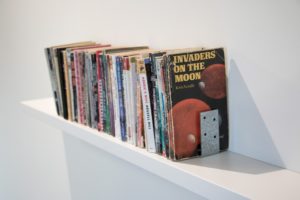Buttons, glass jars, tape. In the exhibition At Random, artist Hyang Cho brings a new perspective to mundane items like these.
Originally from Korea, Cho relocated to Canada about 15 years ago and currently lives in Guelph, Ontario. Learning how to navigate a different country with a new language has been a wellspring of inspiration for the artist.
“I use language, specifically English, as a primary medium of many of my works to express the otherness and anxiety I feel in everyday life,” she says. “What are supposed to be natural actions like speaking, listening, writing, and reading becomes unnatural. That’s why I think that misunderstanding, confusion, uncertainty became a part of my everyday life. The misunderstandings and distortion that I feel in everyday life, because of the language barrier, are very positive aspects and not negative aspects. If the audience does not understand my work, I don’t think it’s a bad thing.”

In Cho’s work, ordinary materials are transformed into a contemporary magic that is simple and sophisticated. One of the pieces featured in At Random is made out of conventional glass jars that are broken into fragments and reworked into a striking glass sphere. This piece exemplifies the complicated elegance that Cho applies to the entire exhibition. Each work is challenged by the presence of time and meticulous process—no object undergoes the same process, and each gets its own laborious effort. Cho examines the feelings and emotions evoked by the march of time and grounds her work in this concept.
“The passing of time, in every day—it’s not just the memorable events you need to measure, but the passing, accumulating, or repeating,” she says.
The pieces in At Random are simply that. They are disparate, and they are collected over a period of time. Some of the items are connected to Cho personally, while others are scavenged for at thrift stores or taken from donation piles. For example, in the exhibit, Cho features a string of buttons sorted from smallest to largest. Half of them belonged to her mother while the other half were found thrifting.
“Everything is equal to me,” she says. “I don’t have a specific, favourite button compared to the other buttons that are special to me. I collect a bunch of buttons. I collect a bunch of jars, I collect the papers. I like them as an object that I can touch, and feel, and sort, and count… But I have an attachment to the result of my work, but not to the individual things.”
Another piece in the exhibit features handwritten transcriptions of letters that Hyang collected from a Google search. The letters vary in language, and the content remains mostly unknown to the artist.
“I just Googled “handwritten letters” in a certain language and just collected a bunch of them,” she says. “Because I don’t know the content, I just chose whatever I liked the appearance [of]. I know some of them are personal love letters, but there are some letters that I was able to read, like old Korean letters. When the language is different, the context keeps changing from the viewer’s view, not from my view, I think.”
Cho does not predetermine how people should perceive the exhibition, and instead believes that each viewer’s subjective experience contributes to her message.
“A certain audience who speaks a specific language who comes to the show and reads some of the specific letters will perceive the whole letter scene in that context, or not, so I think it can open up the meaning of the expression in a certain way,” she says, “not confine them.”
At Random
Friday, November 9 to Sunday, December 16
Free, Open Space
openspace.ca
